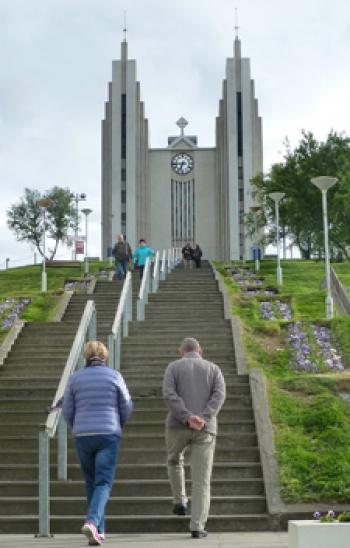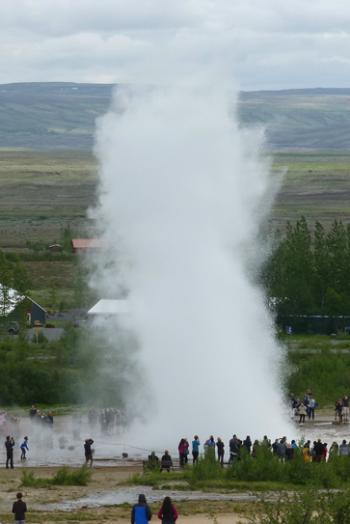Iceland
This item appears on page 56 of the October 2016 issue.
Iceland (First of three parts)
To be certain, I had expected to encounter appealing landscapes on my June 2016 journey in a European island nation where, in a banishing of darkness at the height of summer, the sun never really sets.
I was traveling, partially hosted by ElderTreks (Toronto, Canada; 800/741-7956, www.eldertreks.com), in amazing Iceland, where the adventure-tour operator (and advertiser in ITN) annually offers an 11-day tour. ElderTreks runs small-group tours, and our intrepid band of eight Americans and three Canadians was under the direction of an expert guide, Gugga Eiriksdóttir.
While we, indeed, were truly engulfed in natural beauty throughout our journey, the main appeal of our itinerary was the unique, varied and, often, dramatic experiences we had each day.
In addition, it was refreshing, in light of recent world events, to be visiting what is currently rated as the world’s most peaceful country, according to the Global Peace Index (produced by the Institute for Economics & Peace).
Despite the fact that Iceland is considered a relatively expensive destination, Statistics Iceland reports that the country experienced a dramatic increase in annual visitors between 2010 and 2015, with the number of overnight stays more than doubling, from three million to 6.5 million.
The international airport outside of Reykjavik is coping with the increased visitor traffic so far but is clearly taxed.
Iconic to Iceland
On our first day, we would head from the capital, Reykjavik (with, including suburbs, a population of 175,000, just over half of the country’s population), to Flúðir for an overnight stop.
Before setting out, we visited Hallgrímskirkja, a Lutheran church whose 73-meter tower can be seen from almost anywhere in the city. Its interior was relatively plain, with the main feature being a gigantic pipe organ. Most of us took the elevator to a viewing deck, which provided expansive views across the city.
We then ventured inland, taking time to explore Þingvellir (Thingvellir) National Park, a UNESCO World Heritage Site and the location of Iceland’s first parliament.
At the park, we entered a geothermal wonderland accented by seemingly endless fields of blooming Alaskan lupines, an alluring purple cover. This was our first exposure to the expansive mountain landscapes with cascading waterfalls for which Iceland is known. A hike to a foss (waterfall) helped prepare us for the days to follow.
Driving on to a site at the edge of the North American tectonic plate, we tried to grasp the magnitude of our surroundings.
We also viewed some of the hothouses that abound in the country’s milder climatic regions. Throughout our journey, we would enjoy tantalizing foods, like strawberries and mushrooms, grown locally in these greenhouses.
At our first of many encounters with the handsome Icelandic horses, I was awe-struck. In addition to possessing special walking, trotting, galloping and cantering skills, they can glide across quite rough terrain with a unique and mesmerizing tölt (a smooth gait).
Arriving with the first settlers, Icelandic horses have remained true to their stocky Scandinavian breed, thanks to a 10th-century ban on further imports of horses. Found in a wide variety of colors and markings, they are particularly even-tempered, so it is no surprise that horseback excursions are popular across the island. These 4-legged charmers have replaced geysers as the Icelandic attraction most often posted on Instagram.
The following day, we enjoyed the first of several geyser experiences with a visit to Strokkur, which, every 10 minutes or so, shoots water and hissing steam to heights approaching, at times, 100 feet.
We made our way to nearby Gullfoss, a waterfall cascading into the canyon Hvítargljúfur. Waterfalls throughout the country have few protective barriers, and the multiple viewing sites at spectacular Gullfoss are no exception.
Good fortune was smiling on us the next day, as Gugga announced that the road through the interior to the northern part of the island had just opened for the season. This road is more scenic and more interesting than the portion of the island-circling Ring Road that we would have taken closer to the west coast.
So off we ventured into the vast, barren, lava-strewn moonscape, negotiating 174 kilometers of gravel road. The expansive vistas had a rather intoxicating otherworldly appeal, accented by our lunchtime stop at Hveravellir, a small geothermal oasis, where we made the most of an opportunity to soak in the natural rock-lined, outdoor hot springs pool.
As I’m addicted to such hot springs, I was the first one in and the last one out.
A cetacean wonderland
Green farmland signaled our arrival to the north coast and scenic Akureyri. Situated on a large fjord, the city of 18,000 is a major fishing port. Despite having a rather small city center, Akureyri is the north-coast base for educational and recreational happenings, which gives it the feel of a larger place.
It is perhaps best known for its midnight sun in May and June, when the sun only flirts with setting by touching the sea before beginning its rise to the new day. After exploring the city center and numerous neighborhoods on an afternoon solo hike, I concluded Akureyri to be a place with an enviable quality of life.
The next morning, after visiting the city’s charming and peaceful botanical gardens, we stopped to visit breathtaking Goðafoss before setting off for the whale-watching mecca of Húsavík (pop. 2,500), our base for the next two nights.
From Húsavík’s harbor, we embarked on a 3-hour cruise aboard a restored, 50-year-old, oak herring boat. Blessed by sunny weather and calm seas, after about 45 minutes we arrived near the western shore of Skjálfandi Bay, where, from a distance, there appeared to be a lot of activity involving several boats.
As we drew nearer, we began to spot both humpback and minke whales, the most common of the 11 types of whales found in the bay. At first, we saw a few, then suddenly whales seemed to be surfacing and diving in all directions. My camera’s shutter was clicking madly for over an hour.
I also was captivated by the plethora of seabirds at work around the whales as well as by a few playful dolphins — overall, an idyllic wild-nature setting and a clear trip highlight.
Back on shore, I strolled the quiet streets of tidy Húsavík village around our hotel and the nearby waterfront. It was great to be staying put for two nights.
That evening, busily engaged in editing photos and listening to the voices of neighbor children playing outside, I happened to glance at the clock and was shocked to see that it was just after midnight.
The time-monitoring process takes on a whole new dimension when visiting the far north in midsummer. Thankfully, we were not having an early morning.
In part two of this series, I describe our journey to the northeast followed by the breathtaking southeast of the island. F
You may reach Randy at 80 America Way, Jamestown, RI 02835; 401/560-0350, [email protected].




